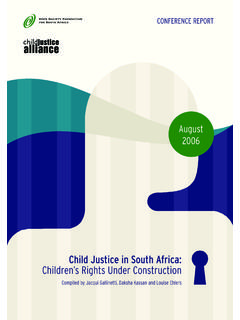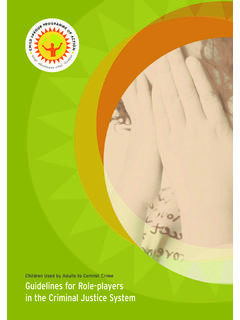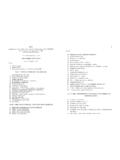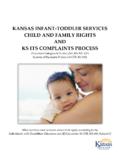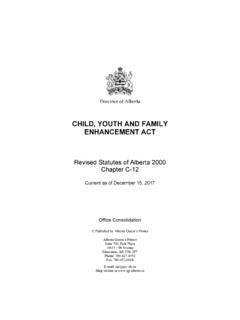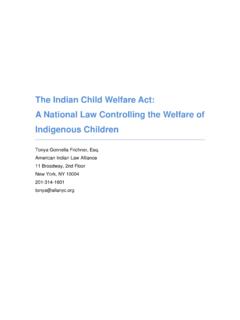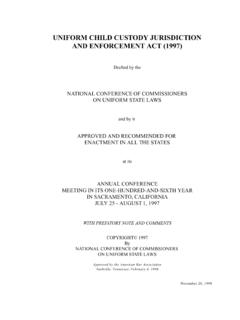Transcription of Getting to know the Child Justice Act
1 Getting to know the Child Justice ActJacqui GallinettiGetting to know the Child Justice ActJacqui GallinettiPublished byThe Child Justice Alliancec/o The Children s Rights Project, Community Law CentreUniversity of the Western CapePrivate Bag X17 Bellville, 7535 Copies of this publication can be obtained from: The Children s Rights Project, Community Law Centre, University of the Western Cape, Private Bag X17, Bellville, 7535. Tel: 021 959 2950, Fax: 021 959 2411, email: views expressed in this publication are in all cases those of the writer concerned and do not necessarily reflect the views of the Open Society Foundation for South Africa, the Child Justice Alliance or the Community Law Centre, University of the Western Cape.
2 ISBN No: 978-1-86808-699-3 Copyright The Child Justice Alliance, c/o The Chidren s Rights Project, Community Law Centre (University of the Western Cape), informationJacqui Gallinetti is a Senior Lecturer in the Faculty of Law, University of the Western Cape. She is also the former Project Co-ordinator of the Children s Rights Project of the Community Law Centre. Legal DisclaimerInformation contained in this publication is for general information on the provisions of the Child Justice Act 75 of 2008. In particular, the information contained in this book does not constitute any form of specific legal advice but rather contains an overview of the Act for purposes of awareness.
3 AcknowledgmentsThe Child Justice Alliance wishes to thank the Open Society Foundation for South Africa for its generous financial support in producing this publication. The Alliance would also like to thank Jacqui Gallinetti, for drafting the contents of this publication, and the members of the Child Justice Alliance Driver Group for their useful input and comments on earlier Kassan and Lorenzo WakefieldDesign and layoutOut of the Blue Creative Communication Solutions, 021 947 3508, p3 PrefaceThis publication is intended to provide the reader with a simple overview of the contents of the Child Justice Act 75 of 2008 (the Act).
4 It attempts to reduce the legalise of the Act; remove constant cross-references to other sections; and bring themes together in a logical and user-friendly is not intended to be a commentary on the provisions of the Act nor a comparison of the Act with the 2002 and 2007 versions of the Child Justice Bills that informed its final content. Nor is the publication intended to constitute a type of training material on the Act. This publication should rather be used as an easy reference source when there is confusion about some of the provisions of the Act and what they actually are intended to mean.
5 In addition, it sets out as best as possible the duties of the key role-players at the end of each section. It also provides a list of sources which the reader can refer to for further information if needed. ContentsPreface ..3 Terms and abbreviations ..6 Introduction ..7 International and constitutional principles underpinning the new law ..9 Preamble, objects, guiding principles, definitions and key role-players in the Act ..12 Scope and application of the Act ..15 Age and criminal capacity ..17 Methods of securing a Child s attendance at the preliminary inquiry ..23 Pre-trial detention.
6 26 Pre-trial assessment ..33 The preliminary inquiry ..38 Diversion ..43 The Child Justice court ..51 Sentencing ..53 Legal representation ..58 Expungement of records ..60 General provisions ..62 Useful websites ..64 Appendix A: Map illustrating a Child s passage through the criminal Justice system ..65 Appendix B: Schedule of offences ..66 Terms and abbreviationsthe Act The Child Justice Act 75 of 2008the Commission The South African Law Reform CommissionBeijing Rules The United Nations Standard Minimum Rules on the Administration of Juvenile JusticeACRWC African Charter on the Rights and Welfare of the ChildCRC Criminal Record CentreCUBAC Children Used By Adults to Commit CrimeCPA Criminal Procedure Act 51 of 1977 DPP Director of Public ProsecutionsIMC Inter-Ministerial Committee on Young People at RiskISCCJ Inter-Sectoral Committee for Child JusticeNPA National Prosecuting AuthoritySAPS South African Police ServiceUNCRC
7 United Nations Convention on the Rights of the ChildUN JDL United Nations Rules for the Protection of Juveniles Deprived of their Liberty p7 IntroductionThe Child Justice Act 75 of 2008 (the Act) has had a long and tumultuous history. The process which resulted in the Act being signed into law on 7 May 2009 began in late 1996 with the appointment of a Project Committee of the South African Law Commission (as it was then known but now known as the South African Law Reform Commission) to investigate juvenile Justice . This Committee began work in 1997 and in 2000 finalised its Report on Juvenile Justice together with a draft Child Justice Bill.
8 This draft Bill was submitted to the Department of Justice and in 2002 it was introduced to parliament as Bill 49 of 2002. The law reform process that resulted in the Act consisted of varied consultations, research and debates. Firstly, the Project Committee prepared an Issue Paper followed by a Discussion Paper, both of which were distributed widely in order to elicit comments. The subsequent responses were then collated into their Report on Juvenile Justice released in 2000. One of the major innovations regarding the consultative process undertaken by the South African Law Reform Commission (the Commission) was the fact that they undertook a consultation study with children.
9 The purpose of this endeavour was to ensure that children s voices were also heard in the drafting of new laws that affected them. The Project Committee also commissioned a costing of the Bill in order to comply with fiscal requirements for new legislation and held workshops on issues such as age and criminal capacity. Secondly, after the Commission finalised its work, civil society also embarked on a series of consultations and undertook various studies as part of its preparations for the Bill being debated in parliament. The Child Justice Alliance, a civil society network established in 2001 to garner support for the Bill, held workshops in all 9 provinces in 2001.
10 It has also produced a range of research reports including two quantitative studies of the criminal Justice system pertaining to children in South Africa (one dealing with the period 1995 2001 and the other dated 2007); an annotated bibliography of all Child Justice publications in South Africa and a baseline study of children in the criminal Justice system in 3 magisterial districts. The Alliance also conducted a follow-up Child consultation study on the draft Bill produced by the Commission. Finally, after the Bill was introduced into parliament in 2002, it was the subject of extensive debates during 2003, and again (unusually but on account of the long delays in processing the Bill) in 2008.
